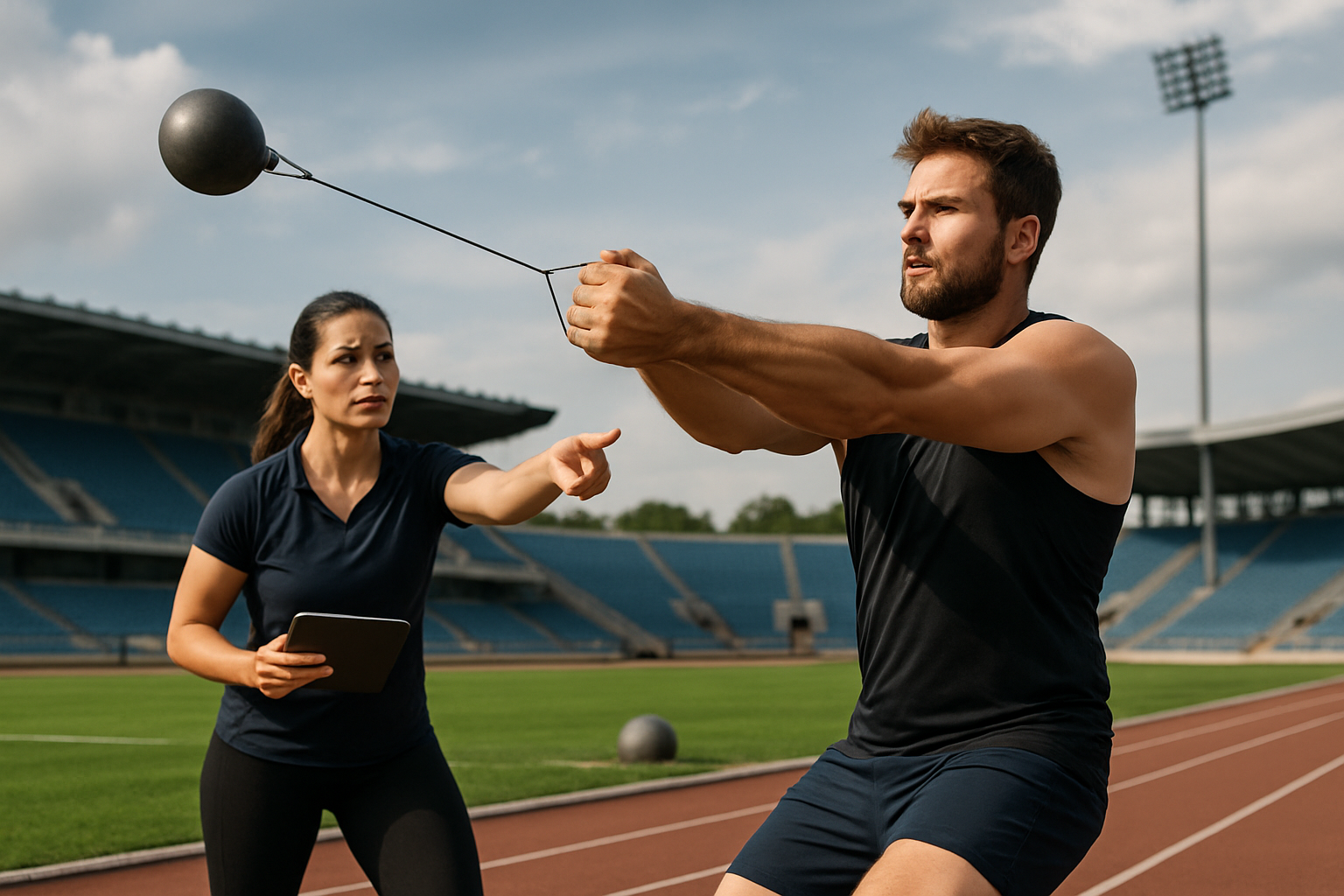The Resurgence of Hammer Throwing: A Modern Twist on Ancient Sport
From the mists of ancient Greece to the high-tech stadiums of today, hammer throwing has weathered millennia, evolving yet preserving its primal essence. This often-overlooked track and field event is experiencing a renaissance, blending raw power with precision technique. As we delve into the world of hammer throwing, we'll uncover its rich history, explore modern training methods, and reveal why this ancient discipline is capturing the attention of a new generation of athletes and spectators alike.

The transformation from a crude implement to the modern hammer occurred gradually. By the 19th century, the hammer had evolved into a metal ball attached to a wire and handle, closely resembling the tool used in competitions today. This standardization paved the way for hammer throwing’s inclusion in the Olympic Games, first appearing in the 1900 Paris Olympics for men, though women’s hammer throw wouldn’t be added until the 2000 Sydney Games.
Throughout the 20th century, hammer throwing techniques underwent significant refinement. The introduction of the heel-toe turn by American throwers in the 1950s revolutionized the sport, allowing for greater rotational speed and, consequently, longer throws. This technique remains the foundation of modern hammer throwing, though it continues to be honed and perfected by elite athletes.
The Physics Behind the Throw
At its core, hammer throwing is a masterclass in applied physics. The athlete must generate and control immense centripetal forces while maintaining balance and rhythm. The hammer, weighing 7.26 kg for men and 4 kg for women, is swung in a circular motion to build momentum before release.
The key to a successful throw lies in the thrower’s ability to accelerate the hammer through each turn. As the athlete rotates, they create a larger radius, which increases the tangential velocity of the hammer. This acceleration is crucial, as the final velocity at the point of release directly correlates to the distance thrown.
Angular momentum plays a vital role in the throw. The athlete must transfer their body’s angular momentum to the hammer, a process that requires precise timing and coordination. The release angle, typically around 44 degrees, is optimized to balance the hammer’s initial velocity with the effects of air resistance and gravity.
Understanding these physical principles is essential for athletes and coaches alike. Modern training regimens incorporate sophisticated biomechanical analysis to fine-tune each aspect of the throw, from the initial winds to the final release.
Modern Training Techniques and Technology
Today’s hammer throwers benefit from a confluence of traditional strength training and cutting-edge technology. While raw power remains fundamental, the emphasis has shifted towards developing explosive strength and rotational speed.
Strength training for hammer throwers focuses on exercises that mimic the rotational forces experienced during throws. Olympic lifts, medicine ball throws, and plyometrics are staples in building the explosive power needed for elite performance. However, it’s the integration of technology that’s truly revolutionizing training methods.
High-speed cameras and motion capture systems allow coaches to analyze every nuance of an athlete’s technique. This data-driven approach enables the identification of inefficiencies in form that are imperceptible to the naked eye. Athletes can then make micro-adjustments to their technique, optimizing their power transfer and improving throw consistency.
Wearable technology has also found its place in hammer throwing. Inertial measurement units (IMUs) attached to athletes provide real-time data on rotational velocity, acceleration, and body position throughout the throw. This immediate feedback allows for rapid iteration and improvement during training sessions.
Virtual reality (VR) is emerging as a valuable tool for mental preparation. Throwers can simulate competition environments, practicing their routines and managing pre-competition anxiety without the physical strain of actual throws. This mental conditioning is proving invaluable in high-pressure competitive scenarios.
The Global Landscape of Hammer Throwing
While hammer throwing may not command the same spotlight as sprinting or long jump, it boasts a vibrant and competitive global community. Eastern European countries, particularly Russia, Poland, and Hungary, have historically dominated the sport, producing a long line of Olympic and World champions.
However, the landscape is shifting. Countries like the United States, China, and Japan are investing heavily in their hammer throwing programs, leading to a more diverse field of elite competitors. This global spread of talent is elevating the sport’s profile and pushing performance boundaries.
The women’s event, in particular, has seen remarkable progress since its Olympic debut. World records have been broken multiple times, with the current mark standing at an impressive 82.98 meters, set by Poland’s Anita Włodarczyk in 2016. This rapid advancement in women’s hammer throwing is inspiring a new generation of female athletes to take up the sport.
Collegiate programs, especially in the United States, are playing a crucial role in developing talent. Many universities now offer specialized coaching and facilities for hammer throwers, creating a pipeline of skilled athletes who can compete at the international level.
Challenges and Controversies
Despite its ancient lineage and Olympic status, hammer throwing faces several challenges in the modern sporting world. Safety concerns have led to its exclusion from many track and field meets, as the implement’s potential flight path poses risks to other athletes and spectators. This limited exposure affects the sport’s popularity and the development of young talent.
Doping scandals have also cast a shadow over hammer throwing. Like many strength-based events, it has been marred by high-profile cases of performance-enhancing drug use. Stringent testing protocols and increased education are being implemented to combat this issue and restore public confidence in the sport’s integrity.
The technical nature of hammer throwing can make it difficult for casual spectators to appreciate. Unlike the immediate drama of a sprint or the visible strain of a high jump, the nuances of a good hammer throw are often lost on untrained eyes. Efforts are being made to enhance spectator experience through better camera angles and real-time data displays during broadcasts.
The Future of Hammer Throwing
As we look to the future, hammer throwing stands at a crossroads. The sport must balance its rich traditions with the need to evolve and attract new participants and audiences. Innovations in equipment design, such as safer cage systems, could allow for more widespread inclusion in track and field events.
There’s a growing push to make the sport more accessible at the grassroots level. Programs introducing modified hammers in schools are gaining traction, allowing younger athletes to experience the thrill of throwing in a safe environment. This early exposure is crucial for building a sustainable pipeline of future champions.
Technology will continue to play a significant role in the sport’s development. Advances in material science could lead to hammers that fly further while maintaining safety standards. Meanwhile, augmented reality (AR) applications might offer spectators new ways to engage with the event, providing real-time data overlays and comparisons to historical throws.
The globalization of hammer throwing is likely to accelerate, with emerging nations challenging the traditional powerhouses. This increased competition will drive performance standards higher and potentially lead to new world records in both men’s and women’s events.
The Cultural Significance of Hammer Throwing
Beyond its athletic merits, hammer throwing carries deep cultural significance in many parts of the world. In Scotland, it remains a beloved feature of Highland Games, connecting modern participants to their ancestral heritage. The sport embodies values of strength, skill, and perseverance that resonate across cultures.
For many athletes, hammer throwing represents more than just a chance at medals. It’s a test of character, demanding years of dedication and solitary practice. The mental fortitude required to excel in this technically demanding event often translates to success in other areas of life, making hammer throwers some of the most well-rounded and resilient athletes in track and field.
The hammer throw community is known for its camaraderie and mutual respect. Competitors often form close bonds, sharing techniques and supporting each other’s progress. This spirit of collaboration, even in the face of fierce competition, sets hammer throwing apart in the often individualistic world of athletics.
Biomechanics and Injury Prevention
The unique demands of hammer throwing necessitate a deep understanding of biomechanics to maximize performance and prevent injuries. The rotational forces exerted on the body during a throw can place significant stress on the musculoskeletal system, particularly the lower back, shoulders, and knees.
Advanced biomechanical studies have revealed the importance of proper alignment throughout the throw. The kinetic chain, from the ground reaction force through the legs, core, and arms, must be optimized for efficient energy transfer. Any weak link in this chain not only reduces throwing distance but also increases the risk of injury.
Injury prevention strategies focus on developing core strength, improving flexibility, and maintaining proper technique even under fatigue. Proprioceptive training is increasingly emphasized to enhance body awareness and control during the high-speed rotations of a throw.
Coaches and sports scientists are also exploring the role of periodization in hammer throwing training. By carefully structuring training loads and intensities throughout the year, athletes can peak for major competitions while minimizing the risk of overuse injuries.
The Role of Mental Preparation
While physical prowess is crucial, the mental aspect of hammer throwing is equally important. The event requires intense focus, spatial awareness, and the ability to perform under pressure. A single lapse in concentration can result in a foul throw or a suboptimal release.
Sports psychologists work closely with hammer throwers to develop mental strategies for competition. Visualization techniques are commonly employed, with athletes mentally rehearsing every aspect of their throw before stepping into the circle. This mental practice helps reinforce muscle memory and builds confidence.
Pre-throw routines are another critical component of mental preparation. These ritualized sequences of actions help athletes center themselves and enter the optimal psychological state for performance. From breathing exercises to specific physical gestures, these routines are as individual as the athletes themselves.
The ability to manage competitive stress is paramount. Hammer throwers must learn to channel nervous energy productively, maintaining composure even when facing world-class opponents or challenging weather conditions. Mental toughness training, including exposure to simulated high-pressure situations, is increasingly incorporated into elite throwers’ regimens.
Technological Innovations in Equipment
While the basic design of the hammer has remained relatively constant, subtle innovations continue to push the boundaries of performance. Material science plays a crucial role in developing hammers that maximize legal weight distribution for optimal flight characteristics.
The wire connecting the ball to the handle has seen significant development. Modern wires are designed to minimize air resistance and maintain rigidity during the throw, ensuring that energy is efficiently transferred from the athlete to the implement.
Handle design has also evolved. Ergonomic grips allow for better control and reduce the risk of the hammer slipping during the throw. Some handles now incorporate sensors that can measure grip pressure and rotation speed, providing valuable data for technique analysis.
The throwing circle itself has seen technological advancements. Some facilities now use circles with embedded force plates, allowing for precise measurement of ground reaction forces throughout the throw. This data helps athletes and coaches optimize weight transfer and timing.
The Environmental Impact of Hammer Throwing
As with many sports, there is growing awareness of hammer throwing’s environmental footprint. The construction and maintenance of throwing facilities, particularly the large safety cages required, can have significant environmental impacts.
Efforts are being made to develop more sustainable practices within the sport. Some facilities are experimenting with recycled materials for circle construction and exploring ways to make safety cages more eco-friendly without compromising their protective function.
The implements themselves are being scrutinized for their environmental impact. While durable, the metal balls used in hammer throwing are not easily recyclable at the end of their competitive life. Research is ongoing into alternative materials that could maintain performance standards while being more environmentally friendly.
Water usage for field maintenance is another area of concern, especially in drought-prone regions. Advanced irrigation systems and drought-resistant grasses are being implemented in some venues to reduce water consumption.
The Economics of Hammer Throwing
Despite its niche status, hammer throwing has its own economic ecosystem. Elite throwers can earn a living through a combination of competition prize money, sponsorships, and, in some countries, government support for Olympic athletes.
The market for hammer throwing equipment, while specialized, is significant. Manufacturers invest in research and development to create implements that meet stringent competition standards while offering performance advantages. This industry supports a network of suppliers, retailers, and technicians.
Hosting hammer throwing events can bring economic benefits to local communities. While not on the scale of major track and field championships, specialized hammer throwing competitions attract participants and spectators, boosting local hospitality and retail sectors.
The coaching economy around hammer throwing is also noteworthy. Specialized coaches command premium fees for their expertise, and training camps and clinics provide additional revenue streams within the sport’s community.
Hammer Throwing in Popular Culture
While not a mainstream sport, hammer throwing occasionally breaks into popular culture, often as a symbol of raw strength and skill. Films and television shows have featured hammer throwing scenes, sometimes for dramatic effect, other times as a backdrop for character development.
In literature, the hammer throw has been used metaphorically to represent the struggle against limitations, both physical and mental. The image of an athlete spinning with controlled power before releasing the hammer serves as a potent symbol of human potential.
Video games, particularly those focused on Olympic sports, often include hammer throwing events. These digital representations help introduce the sport to new audiences and can spark interest in real-world participation.
Social media has provided a platform for hammer throwers to share their experiences and connect with fans. Many elite athletes use platforms like Instagram and YouTube to offer behind-the-scenes glimpses of their training and competition experiences, helping to demystify this ancient sport for modern audiences.
The Educational Value of Hammer Throwing
Beyond its competitive aspects, hammer throwing offers significant educational value. The sport provides a practical, engaging way to teach principles of physics, particularly in areas such as rotational motion, centripetal force, and projectile trajectories.
In physical education settings, modified hammer throwing activities can help students develop coordination, balance, and spatial awareness. The focus on technique over raw strength makes it an inclusive activity that can benefit students of various physical abilities.
The historical aspects of hammer throwing offer opportunities for cross-curricular learning, connecting physical education with subjects like history and cultural studies. Exploring the sport’s evolution from ancient times to the modern Olympic event can provide valuable insights into the development of athletic competition and its role in society.
Hammer Throwing and Gender Equality
The relatively recent inclusion of women’s hammer throw in the Olympic program highlights ongoing efforts to achieve gender equality in athletics. The rapid progression of women’s performance in the event demonstrates the importance of providing equal opportunities and resources across genders.
Efforts are being made to increase female participation at all levels of the sport, from grassroots programs to elite competition. Many countries are investing in women’s hammer throwing programs, recognizing the potential for medal success and the broader social benefits of promoting women in sport.
The success of female hammer throwers has challenged stereotypes about strength and athleticism. Top female throwers serve as powerful role models, inspiring young girls to pursue their athletic ambitions without regard to outdated gender norms.
The Global Community of Hammer Throwers
Despite its individualistic nature, hammer throwing fosters a strong sense of community among its practitioners. International competitions serve not only as athletic events but also as gatherings where throwers from diverse backgrounds can share knowledge and experiences.
Online forums and social media groups dedicated to hammer throwing have created a global network where athletes, coaches, and enthusiasts can discuss technique, training methods, and equipment. This digital community plays a crucial role in preserving and evolving the sport’s knowledge base.
Mentorship is highly valued within the hammer throwing community. Experienced throwers often take younger athletes under their wing, passing down not just technical skills but also the sport’s ethos of hard work and continual self-improvement.
Conclusion: The Enduring Appeal of Hammer Throwing
As we’ve explored, hammer throwing is far more than a simple test of strength. It’s a complex discipline that combines physical power with technical precision, mental fortitude with strategic thinking. The sport’s rich history and ongoing evolution make it a fascinating subject for athletes, scientists, and spectators alike.
While hammer throwing may never achieve the mainstream popularity of sprinting or jumping events, its dedicated community ensures its continued relevance in the world of athletics. The blend of ancient tradition and modern innovation that characterizes hammer throwing speaks to the enduring human desire to push the boundaries of physical achievement.
As the sport continues to develop, embracing new technologies and training methods while honoring its historical roots, hammer throwing stands as a testament to the diverse and captivating nature of track and field athletics. Whether viewed as a competitive event, a physics lesson in motion, or a link to our athletic heritage, hammer throwing remains a compelling and vital part of the sporting world.





